Steven Pressfield's Blog, page 63
February 1, 2017
Tk Ths Job n Shove It
[This is Post #2 in our new series, “The Professional Mindset.”]
When you and I were working on the line at Ford in Dearborn, we had to worry about our production quotas, our standards of workmanship, our supervisor’s evaluations of us.
What we didn’t have to worry about was the structure of our day.
That structure was imposed on us from outside.

Nope, we ain’t making these no more.
Then one day we quit.
Suddenly we were artists.
We were entrepreneurs.
We thought it would be easy. We were free! Nothing could stop us!
It turned out to be the hardest thing we’d ever done.
Suddenly, like Dorothy swept up from Kansas or Luke following Obi-wan Kenobi, we had embarked upon our own Hero’s Journey. We had left the Ordinary World and entered the Inverted World, the Extraordinary World.
In this new world, all things became possible. Our life could change. Our future could change. Our prospects could change.
There was only one problem: we ourselves had to change.
We could not survive in the Extraordinary World using the mindset that had worked for us in the Ordinary World.
How exactly did we have to change?
We had to make the mental shift from externally-imposed discipline to self-discipline.
This, in one sentence, is the difference between the laborer-for-hire and the entrepreneur.
This is the Professional Mindset.
I begin each day of my life with a ritual. I wake up at 5:30 A.M., put on my workout clothes, my leg-warmers, my sweatshirts, and my hat. I walk outside my Manhattan home, hail a taxi, and tell the driver to take me to the Pumping Iron gym at 91st Street and First Avenue, where I work out for two hours [before heading to my dance studio to begin the day’s work.] The ritual is not the stretching and weight training I put my body through each morning at the gym; the ritual is the cab. The moment I tell the driver where to go I have completed my ritual.
Do you see the Professional Mindset in this passage from Twyla Tharp’s The Creative Habit?
I’ve quoted these sentences before, and I’m sure I’ll cite them again and again because they so eloquently articulate the Mindset of the Artist.
Encapsulated within Ms. Tharp’s morning ritual are virtually all the qualities of mental toughness that the artist/entrepreneur needs:
Self-motivation.
Self-discipline.
Self-reinforcement.
Self-validation.
Self-belief.
And they’re all wrapped up in the artist/entrepreneur’s secret package: habit.
When you and I worked on the line at Dearborn, we didn’t need the Professional Mindset. Ford supplied that for us.
Ford told us when to show up for work and where. It told us what attitude we must have when we arrived for work and what state of mind we must maintain throughout the day (cheerful, alert, patient, collaborative, committed, professional, imbued with aspiration for excellence and a vision of the big picture melded simultaneously to the capacity for attention to detail.)
Ford told us how many hours we had to stay on the job, how many days a week, how many months a year. It told us when we could go to lunch, when we could take a vacation, when we could leave the line to heed nature’s call.
Ford even supplied a factory whistle to tell us when the day was over and we could go home.
We were not amateurs at Ford. We were professionals. But we were professionals whose professionalism was imposed upon us from outside by our employer, under penalty of disciplinary action, penalty of fine, penalty of termination.
There’s nothing wrong with any of the rules or strictures that Ford or any other company imposes on its employees. If you and I were running a similar enterprise, we’d make our workers do exactly the same. It’s how good cars get made. It’s how professional work gets done. It’s how a business survives and prospers.
What exactly, we might then ask, is the Professional Mindset … the mindset of the individual who has left the factory and has set herself up as an artist and an entrepreneur on her own?
What should she do differently from when she worked on the line?
Answer: We do exactly what we did when we were working for Ford, only instead of Ford telling us what to do, we tell ourselves.
Instead of Ford setting the agenda, we set it.
We decide what our goal is—and how we intend to reach it.
We decide how much we’re willing to sacrifice to reach that goal.
We decide how many hours we will work (our total, bank on it, will be MUCH HIGHER than it was at Ford) and how many weeks and months per year.
We decide where we will work.
We decide when.
And with whom.
We decide what time we get up and what time we go to bed. We assign our own vacations and our own days off. (We also assign all-nighters and working weekends.)
We alone will be the arbiters of our success.
We’ll give ourselves a raise if we deserve it.
And we’ll kick ourselves in the butt when we screw up.
We will be our own boss, our own employer, our own mentor and teacher and psychiatrist.
Can you make that mental shift?
Can you flip that switch in your head?
Can you be your own master, run your own show without adult supervision?
If your goal is to be a writer or an artist or an entrepreneur, you can’t do it any other way.
January 27, 2017
Love Story Cheat Sheet/Obligatory Scenes
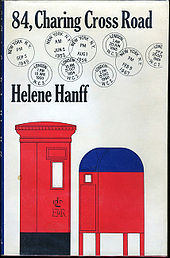
If the lovers never “meet,” can the love story work?
This is the fifth in my series about love story. If you’d like to catch up, here is the first one, here is the second one, here is the third one and here is the fourth one.
What scenes must be in every Love Story?
While the following list may seem obvious, you’d be surprised how many amateur writers fail to deliver these essential must-haves. Or if they do deliver them, they toss them off with an uninspired let’s get this over with sensibility, thus disappointing readers looking for something singular and magical.
Lovers Meet Scene.
In order to tell a love story well, we need to bring the two people together.
Duh…
But what if you decided to write a love story in which the lovers don’t actually meet face to face?
Could you do that?
Would it work?
84, Charing Cross Road by Helene Hanff, published in 1970 before our crazy social networking world, worked and the two lovers never met. It’s a memoir/love story with a devastating climax. But it abides the lovers meet scene nevertheless.
You see, the two lovers meet via the UK and US post offices. And their chaste metaphysical connection is absolutely irresistible. The book was so heart wrenching and delivered such an innovative form of love story that it had very successful stage, television and feature film adaptations.
The movie with Anne Bancroft and Anthony Hopkins is a guaranteed rainy day delight. Especially for us sentimental book nerds who yearn for the days when Manhattan had a used book store just a few doors down from our favorite independent movie theater (And there was one of those in every neighborhood) where we’d meet our dates twenty minutes before the Sunday Double Indemnity/Maltese Falcon double feature. (Note to Elon Musk…get working on that time travel machine!)
Confession of Love Scene
This is the scene when one of the lovers declares that he/she is in love with the other. Hey, we’ve all been in that scene ourselves, right? Gets your stomach churning just thinking about it.
You don’t want to mess up this scene. And no, they don’t literally have to say “I Love YOU!” Steve wrote about this scene here.
Where do you put this scene in your global structure?
Well, where you choose to put it will inform the rest of the story…just like where you choose to put the “Lovers Meet” or any of the others that follow.
A lot of writers decide that this scene is best in the middle build. Jane Austen did that with Pride and Prejudice and she made out pretty well. That novel still sells more than 400,000 copies a year, just in the English language. Not bad for a 204 year old book.
A movie that placed this scene as the ending payoff climax in one of its eight! mini-plot love stories is Love Actually, written by Richard Curtis. Two of those, though, were not “love with the possibility of sex” as I’ve been defining love story (the bromance story between the singer and his manager and the child crush subplot).
I’m referring to the unrequited love story between the best friend of the groom who marries Keira Knightley at the beginning of the movie. Saturday Night Live did a great parody of this scene recently using Kate Mckinnon reprising her impersonation of Hilary Clinton. I’ll not spoil it if you haven’t seen the movie, a real cheese-fest that you either surrender to or find treacly and impossible.
First Kiss/Intimate Connection Scene
What many call the “first kiss” scene, I add “intimate connection” to further clarify. The reason being that many great love stories never have the lovers kiss in the narrative. Pride and Prejudice is a perfect example. No one ever kisses in the novel and it’s delightful that they never do. Check our Lawrence Kasdan’s film Body Heat (Film Noir Crime/Obsession Love Story) for a killer first kiss scene if you really want a literal interpretation.
So baring a kiss as the driving climax of this scene, an intimate connection works just as well. The intimate connection scene in Pride and Prejudice is when Mr. Darcy and Elizabeth Bennet discover the facile wit and intelligence that the other possesses. This connection occurs in Chapter Six when Elizabeth, noticing Mr. Darcy’s “satirical eye,” gooses him by confronting him for listening in to her conversation with another man…
“Did you not think, Mr. Darcy, that I expressed myself uncommonly well just now, when I was teasing Colonel Forster to give us a ball at Meryton?”
“With great energy; but it is always a subject which makes a lady energetic.”
“You are severe on us.”
Is there any doubt that these two are meant for each other?
Their verbal teasing is the stuff of intimate connection, which becomes a ritual between them (a convention which I’ll write about in the next post), and is as delightful for the reader to experience as it must have been for Austen to write.
Austen’s “First Kiss” scene is so much better in my opinion than them stealing a kiss in the moonlight after too much champagne. Mr. Darcy and Ms. Bennet would never be so stupid as to drink too much champagne.
Lovers Break Up
This scene is the one where many writers pull their punches.
It’s the equivalent to mystery/crime/thriller writers who don’t go to the end of the line with their “perfect crime” scenarios. Amateur crime writers bake in solutions to their crimes so that they know how their protagonist/hero will come to figure out the criminal before they begin writing. That’s a big mistake. The big work to explore before you write a crime story is to create the perfect crime. And then challenge yourself to mastermind a way to solve it. You must wear both hats. And the antagonist’s hat in the crime story is even more important than the protagonist’s.
Similarly, the tendency for love story writers is to avoid breaking up the lovers too definitively. They want to leave some wiggle room for them to get back together. They do this so that they’ll know weeks or months before they write the scene how they’ll solve the inevitable “Lovers Reunite Scene.” Which is the final resolution of a courtship drama no matter if the lovers commit or part. More on that later.
That’s a mistake (leaving the easy possibility of them getting back together) because you’ll inevitably telegraph how they’ll reconcile to the reader long before it happens. Remember that the “how they reconcile” is the fuel that gets us to the ending payoff. And readers hate it when they figure out how your ending payoff will payoff.
The trick to this scene is to remember that the lovers need to have an internal change before they’ll be capable of coming back together. More on that in the next post.
Elizabeth Bennet and Mr. Darcy both have to change their worldviews before either of them will be capable of authentic commitment. Both must examine their “pride” and “prejudice,” and actively commit to a change of behavior guided by their enlightened point of view.
So when the lovers break up in Pride and Prejudice they do so in an extraordinary way. Austen combines the “Confession of Love” scene with the “Lovers Break Up” scene in a tour de force.
After Mr. Darcy confesses that despite his better judgment, he can’t stop himself from wishing to add Elizabeth Bennet to his possessions and thus he’s decided to make her dreams comes true and accept her as his wife…Elizabeth hits him with double barrels of vitriol. Not only does she decline him because of his arrogant pride, she attacks him and his social class with fury. She essentially tells him that he’s the last man on earth that she would ever love.
This happens just about the middle of the middle build of the novel (Chapter 34 of a 61 Chapter novel)… Just perfect.
Proof of Love Scene
This is the most important scene for the love story. Without a satisfying Proof of Love Scene, your love story will not work.
Like the “Hero at the mercy of the villain” scene for a thriller or the “Exposure of the criminal scene” in a crime story or “The big event” scene in a performance story, the Proof of Love Scene is the thing that every reader is unconsciously waiting for. This is the scene that will turn the entire story from negative to positive or positive to negative.
It’s the core event…the thing that will push someone into committing themselves until death.
The key component in the Proof of Love scene is that one of the lovers must SACRIFICE for the other’s happiness WITHOUT HOPE THAT THEIR ACTION WILL DO THEM ANY GOOD WHATSOEVER. Loving someone and acting on that love by personally suffering… all the while knowing that your sacrifice will not change the other’s mind…is the proof of authentic love.
Authentic love does not require reciprocity. A tough nut to accept, but until you do, you’ll be incapable of living the dream. Remember that this notion is part of the romantic myth which has evolved from the Age of Chivalry to the present.
So how does Jane Austen handle this high task?
She beautifully and gracefully allows Mr. Darcy to prove his love…off the page. This choice was incredibly courageous (not having him make some grand on the page gesture could have really backfired), but this decision is the thing (well one of them) that makes Pride and Prejudice a perfect story.
Why? Because it is perfectly in character.
Austen decided that Mr. Darcy would arrange to solve the Bennet family’s impossible situation (it is suggested that death would be preferable to the predicament they face) behind the scenes. She does not show us the particulars or negotiations he must accomplish to succeed at this task. Rather she has third parties inform Elizabeth about his actions. And their betrayal of his confidence is in character too. These actions provide yet more proof of the fallibility of the average person and the necessity of forgiveness, something Elizabeth and Mr. Darcy have had to painfully learn throughout the novel.
When Elizabeth thanks Mr. Darcy for his efforts, he quickly changes the subject. It’s not to be discussed. He did it simply because he is enlightened now, and knows that love is more important than pride, even in the service of unreciprocated love. His actions are merely those of a proper gentleman.
What Darcy sacrifices is part of his fortune and his pride in order to save his beloved. And he does it without hesitation too.
Mr. Darcy’s proof of love turns the global story and convinces Elizabeth to devote herself to him without reservation. By the way, Elizabeth proves her love for Darcy in an earlier scene. That one, though, is on the page. As it should be. Elizabeth is the central protagonist after all.
The Lovers Reunite Scene
This is usually the resolution scene of the entire love story, most especially the courtship drama or comedy. That is, the lovers get back together and agree to commit to one another. Or decide it’s best that they part ways.
SPOILER ALERT
The recent film, Manchester By The Sea (a very courageous work of writing supported by impeccable performances) used a subplot love story to girder its global Redemption Plot.
The Lovers Reunite Scene in this case does not result in the two lovers getting back together. In fact, it serves as impetus for a heartbreaking negative outcome that turns the global plot irreversibly.
What makes this choice so courageous is that the writer and director Kenneth Lonergan decided that he had to be truthful to the realism of the world he created on the page.
When he was writing, let alone when he was directing, Lonergan had to know that ending his story with a dark negative would really hurt the movie’s chances commercially. But he did it anyway. He didn’t put in a feel good ending. I doubt he ever considered it. Even though redemption relief is what we all want when we watch it…sometimes we just can’t get what we want.
Because the characters he created would not end well.
Contrast this dark decision to another realistic film, Good Will Hunting, a story that explores a similar blue-collar world as Manchester By The Sea. I really enjoyed it and thought it was very well done, but anyone who truly understood the characters in that film knows deep down that it would not have ended well in real life.
The self-hatred the protagonist was consumed by in Good Will Hunting would not have been slayed after one cathartic therapy session…or even a thousand. But that was that key scene that left audiences smiling when they walked out of the theater and it is what pushed the film to a 225 million dollar box office.
Manchester By The Sea won’t come close to Good Will Hunting numbers. By design. It’s not because it’s not truthful to the characters or to the world’s those characters represent. It’s because it is truthful.
To be fair, I think when we’re younger (Ben Affleck and Matt Damon were in their 20s when they wrote Good Will Hunting) we tend to think that lightening bolt catharsis moments are possible. We think one good cry will prime us to move forward. It will get us into our metaphorical life journey cars and we’ll never look back.
A decade or two down the road, though, that kind of magical thinking proves tenuous.
The truth is that our deeply negative experiences refuse our prepared place for them in the rear view mirror. Cry a river, talk yourself silly. No matter. Some just won’t budge from the shotgun seat, their methamphetamine chatter inflicting an inescapable internal torment. Their sounds tend to rise above our better angels’ counter-programming reminders coming from the back seat. For whatever evolutionary reason, loss and regret argue better than gain and satisfaction.
Some things we don’t beat. We endure them.
I think it’s interesting that Matt Damon was a key driver behind the making of Manchester By The Sea. In many ways it’s what could have happened to poor Will Hunting further on down the road.
January 25, 2017
Writer = Entrepreneur
Are you a writer?
A filmmaker?
A dancer?
Then you’re an entrepreneur.

It’s also why I read Seth Godin’s blog every day.
You have more in common with the young Steve Jobs and the early Sergey Brin and Mark Zuckerberg than you do with your dad who worked all his life for AT+T or your aunt who’s five months away from collecting her pension from the Post Office.
[Today’s post, by the way, is the kick-off for a new extended series that I’m calling, until someone comes up with a catchier title, “The Professional Mindset.” Over the succeeding weeks we’re going to examine the inner world of the writer and the artist, not in terms of craft or even of overcoming Resistance, but of self-management.]
What emotional and psychological skills does a writer or artist need to conceive a project, to initiate it in the face of self-doubt and the indifference and even outright opposition of others, to hang tough through the “second act horrors,” to bring the work to completion, and then to take it to market out there in the cold, cruel world.
How should she think of herself, this writer or artist? What is her most effective self-conception? Warrior? Mother? Jedi knight?
Step One, it seems to me, is to recognize that all of us–writers, artists, filmmakers, actors, musicians–are entrepreneurs.
We don’t work for the Man.
We work for ourselves.
These are two completely different modes of operating in the world and of thinking about ourselves.
One way looks outside itself—to a boss, an authority figure, an established organization of which it is a part–for daily structure, for validation, for monetary remuneration.
The other way generates these from within. From her own self and her own labors.
This is an earth-shaking, life-altering, monumental watershed of the mind and the heart.
What is an entrepreneur anyway?
My online dictionary says the word comes from the French, entreprende, “to undertake.” It’s related to “enterprise.”
A person who sets up a business or businesses, taking on financial risks in the hope of profit.
Dan Sullivan of Strategic Coach defines an entrepreneur as
Someone who has an exceptionally personal relationship with the 15th of the month.
Meaning payday.
Payday where nobody is going to cut you a check except yourself.
Payday when YOU are the only one generating income.
The artist, if you think about it, is the quintessential entrepreneur.
On the upside, she possesses total workplace freedom. She can tackle any project she wants, execute it any way she wishes, take it to market any way she chooses. She can write a novel, audition for a Broadway play, compose a symphony, lay out the next Assassins’ Creed.
No one is stopping her. No one is telling her “it can’t be done.” She can rise as high as her gifts will carry her.
On the downside, she is all alone in a stark, indifferent universe.
No one guarantees her an income. No one provides daily structure. No one motivates her, no one mentors her, no one pats her on the back.
That’s an entrepreneur.
Over the coming weeks we’re going to examine what it takes—emotionally and psychologically—to succeed in this raw, often cruel, Wild West universe.
We’re going to take a hard look at the Professional Mindset and how it applies to those of us seeking to make our living/satisfy our soul at the intersection of Art and Commerce.
January 20, 2017
Should Writers Be Paid For Everything?
I received a question following my last post (“Common Sense“), which is tied to writers being paid for their work, and I’m still thinking about the question, and my answer, almost two weeks later.
Here’s the question:
You argue that writers shouldn’t work for free, but isn’t that exactly what they are doing when they spend time on social media? What about their blogs?
I see both as examples of writing as marketing, and no one is paying them.
Doesn’t that go against your point?
Here’s my answer:
On your question, I approach it as I do my yard.
If I mow/rake/weed/etc my own yard, I have to do the work, but I benefit in the future. In the beginning, my yard might be crap, but in a few years it could be a glorious masterpiece due to all the work put into it. I don’t get monetary payment up front, but I learn how to do things on my own, gain professional experience, and benefit from the hours of repeated actions, which help me trouble-shoot in the future, and make me more knowledgeable about the craft. When I sell my house, that yard becomes a selling point and thus has monetary worth.
If someone else maintains my yard, he goes home after doing the work, and doesn’t get any of the future benefits – but, he does get paid, and my neighbor might hire him because he likes the look of my lawn.
So if my site/book/etc is my lawn, I can choose to do the work myself or hire someone else – but in the end the site/book/etc is mine and I benefit from the growth (and possible future sale), which is a type of payment itself.
If I write for someone else’s site, however, there’s no ownership in the future, so I want payment now, kind of like the guy/crew maintaining yards. I can’t count on a neighbor hiring me. I need something that pays the bills.
So both models offer a form of payment — one more immediate than the other. As the person doing the work, I decide which form I’ll take. If I’m writing for “exposure,” I’d rather do it on my own terms instead of helping to drive traffic to people who have money to pay – Huff Post – and don’t.
Going back over the question and answer now, my issue with writing for free isn’t the giving away work for free part.
Long-time readers of this site know that Steve, Shawn, and I are advocates of giving away work as a good way to reach new audiences. HOWEVER, we set the terms for what is given away — and how it is given away — and base the giveaways within the Black Irish Books and Steven Pressfield platforms, neither of which popped up overnight. We’ve been at it on Steve’s site for almost ten years, and he had a static site long before that.
My biggest issue is giving away your opportunity to build your own platform.
When you look at a platform with large audiences, be careful of thinking a place on those platforms will fast-track your success. It won’t. To quote Seth Godin’s “How to Be Heard” post from earlier this week, “Convert six people before you try to convert sixty.”
Resist the temptation to jump to where millions of others are hanging out.
If you’re going to bust your ass, do it for yourself, not for a platform that will either 1) make its executives (and not you) rich off of a sale or 2) take your work down with it when it fails.
Do what grows you before you help grow someone else.
January 18, 2017
50 Ways to say “I Love You”
A case could be made that many, many books and movies are about one thing and one thing only: getting Person X to say to Person Y, “I love you.”
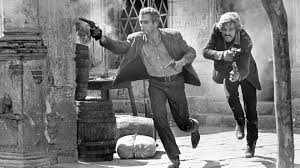
Paul Newman and Robert Redford saying it in subtext in “Butch Cassidy and the Sundance Kid”
The trick is our characters can never use those blatant, overt words. That wouldn’t be cool.
It wouldn’t ring true to life.
And it wouldn’t possess the power and the impact we want.
In fiction, “I love you” has to come in subtext, not text.
Here’s one of the ways William Goldman did it in Butch Cassidy and the Sundance Kid.
It’s the final scene. The outlaws are shot up and bleeding in a cramped hideout in a town square somewhere in Bolivia. Surrounding them, outside, are hundreds of uniformed, rifle-toting Federales. The instant our two “bandidos yanquis” step out through the door … well, we all know what’s coming.
BUTCH
I got a great idea where we should go next.
SUNDANCE
Well I don’t wanna hear it.
BUTCH
You’ll change your mind once I tell you.
SUNDANCE
It was your great ideas that got us here in the first place. I never wanna hear another one of your great ideas.
BUTCH
Australia. I figured secretly you wanted to know so I told you: Australia.
SUNDANCE
What’s so great about Australia?
BUTCH
They speak English there.
SUNDANCE
They do?
BUTCH tells Sundance about the banks, the beaches, and the women Down Under.
SUNDANCE
It’s a long way, though, isn’t it?
BUTCH
Aw, everythings’s always gotta be perfect with you.
SUNDANCE
I just don’t wanna get there and find out it stinks, that’s all.
In Billy Wilder’s The Apartment, junior exec Baxter (Jack Lemmon) has been in love with elevator operator Fran Kubelik (Shirley Maclaine) for the whole movie. But Shirley is blind to Jack’s infatuation. Instead she’s in a doomed affair with married exec Mr. Sheldrake (Fred McMurray). When Shirley tries to poison herself after Sheldrake dumps her, Jack saves her life by getting her stomach pumped and sitting up all night with her playing cards. Next day he stands up to Sheldrake (who’s his boss), quits his job, etc., all the while believing Shirley still has no romantic interest in him.
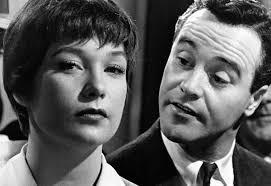
Shirley MacLaine and Jack Lemmon in “The Apartment”
In the final scene Shirley sees the light, races to Jack’s apartment just in time to catch him before he packs up and leaves town.
MISS KUBELIK
What’d you do with the cards?
BAXTER
In there.
Shirley gets the deck. sits beside Jack on the couch.
BAXTER
What about Mr. Shelkdrake?
MIS KUBELIK
We’ll send him a fruitbcake every Christmas. Cut.
He cuts a deuce, she cuts a ten.
BAXTER
I love you, Miss Kubilek
MISS KUBELIK
You got a two, I got a ten. I win.
BAXTER
Did you hear what I said, I absolutely adore you.
MISS KUBELIK
Shut up and deal.
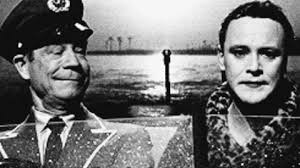
Joe E. Brown and Jack Lemmon in “Some Like It Hot”
Billy Wilder topped this of course with the last line of Some Like It Hot, when Jerry (Jack Lemmon), hiding out from the mob in drag with a girl band, explains to his zillionaire suitor Osgood Fielding III (Joe E. Brown) that he can’t marry him.
JERRY
You don’t understand, Osgood. I’m a man!
OSGOOD
Well, nobody’s perfect.
Subtext beats text every time.
That’s love.
January 13, 2017
Love Story Cheat Sheet /Controlling Idea (Theme)
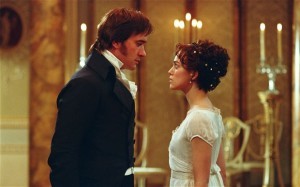
Matthew Macfadyen as Mr. Darcy and Keira Knightley as Elizabeth Bennet in Joe Wright’s Adaptation of Jane Austen’s Pride and Prejudice
This is the fourth in my series about love story. If you’d like to catch up, here is the first one, here is the second one, and here is the third one.
If there is one question I get more than any other it’s this:
“Could you tell me what the controlling ideas/themes, obligatory scenes and conventions are for Genre X?”
Well, I could.
And I did go through the OSs and Cs for Thriller and Crime in The Story Grid book as well as those in the Redemption story (part of the Morality Internal Content Genre) too over at www.storygrid.com.
(And I plan on analyzing each of the twelve content genres, plus some of the reality genres too, with serious coursework specificity in mind before I leave this mortal coil…click here if you have absolutely no idea what I’m talking about.)
But come on…part of being a writer is exploring the story universe you wish to enter all by your lonesome. And there’s no better way than reading a whole bunch of your favorite novels from a particular genre and then compiling a list of what they all have in common.
That’s a lot of work. I know. I’ve done it. You should too.
Getting the answers to the test so you don’t have to study is rather lame, but I get it.
Just like the next guy or gal, I like to know that something is worth learning before I book a long trip into the autodidact’s lonely intellectual desert for an extended stay.
So as I pick up where I left off with the mini-love story genre course I’ve been writing here for What It Takes, I thought I’d just throw down a three part cheat sheet for love story.
So here you go:
What’s the global value at stake in love story?
The value at stake in a love story is…duh…love.
But what spectrum of love are we talking about here?
Here is a nine level list of the varieties of romantic love from the most positive love to the most negative.
Intimacy ++++
Commitment +++
Passion ++
Attraction+
Ignorance ~
Dislike –
Hate —
Indifference —
Hate masquerading as love —-
(HMAL is when someone tells you how much she cares and loves you, but really she can’t stand you. Behind your back she does everything in her power to make you miserable. See Gaslight and Gone Girl.)
So when you set out to write a love story, you’ll need to make a big decision about where you will begin on the love value spectrum (hint…ignorance is a good place to start…that is when the lovers haven’t met yet) and where you’ll end up.
In the last post in this series, I discussed the three subgenres of love story. Here they are again with the movement from beginning to end indicated.
Obsession (Moves from Ignorance to Passionate Desire and usually ends negatively)
Drama (usually ends hugely negative or at most ironically; positive and negative
Comedy (usually ends positive)
Courtship (Moves from Ignorance to Commitment, or lack of Commitment)
Drama (usually ends positive, or ironically; positive and negative)
Comedy (usually ends positive, or ironically; positive and negative)
Marriage (Moves from Commitment to Intimacy, or sinks beneath Commitment negatively on the spectrum)
Drama (usually ends positive, or ironically; positive and negative)
Comedy (usually ends positive, or ironically; positive and negative)
I’ll also restate that the most commercially viable love sub-genre is the Courtship drama and/or comedy that ends positively with a concrete commitment made between the two lovers.
Controlling Idea of the Love Story (often referred to as Theme):
Obviously, the controlling idea (theme) is crucial to the telling and commercial success of a love story.
If you decide to end your Courtship story negatively (the lovers do not end up together) you better have a damn good reason (and a sequel planned to bring them back together).
Remember that the controlling idea is about answering the how and why life has changed.
Have I mentioned before that All Stories Are About Change?
The controlling idea is a simple sentence that explains how the core value of your story fared by the ending payoff.
What caused the move from one place on the value’s spectrum to another?
So as I’ve been putting together a new love story book featuring Pride and Prejudice as the overarching case study, I’ll construct the controlling idea behind that brilliant novel.
First of all, how does it end?
It’s ends positively. The three love stories in the novel result in marriage commitments.
So lets’ begin our controlling idea to reflect that positive ending.
LOVE TRIUMPHS
Great. So now we need to add the “how it changed element” to the sentence.
So how did the love value change in Pride and Prejudice?
It moved from Ignorance (none of the lovers have met at the beginning of the novel) to Commitment. Right, of course, but let’s be more specific than that.
I’m going to focus on the primary love story of the three love stories featured…the one between Elizabeth Bennet and Fitzwilliam Darcy.
How did Mr. Darcy change? How did Elizabeth change? What were the causes of their being able to finally come together and commit with authenticity?
Mr. Darcy had to temper his pride and dispel his prejudice, right? He had to internally move from a negative worldview to a positive worldview.
At the beginning of the story, Darcy finds England’s country folk leave much to be desired. They’re, according to his myopic vision, provincial and ignorant with suspect character and generally untrustworthy. By the end, though, he sees them as having particular charms and deems them worthy of getting to know.
And Elizabeth had to have a worldview correction too, right? She had to shed her reverse prejudice and temper her pride in being above the pragmatism of her era’s mating rituals. Interesting that Darcy and Elizabeth are so similar, isn’t it?
Elizabeth had to internally move from someone who finds all wealthy people ridiculous and abhorrent to someone who has a far better grasp of humanity. She has to mature into someone who knows that all social classes have all different kinds of people. And that class does not determine character. Even rich guys can be morally weighty and capable of romantic feeling.
Her family, which she sees as delightful and charming at the beginning of the story, ends up being far less admirable in her eyes by the end.
And the snooty upper class group as represented by the Darcy and his confidants, which she sees as nasty and negative at the beginning? She ends up actually joining that class by the end. She comes to understand that like her own tribe, the rich are made up of all sorts of different people. The rich can be like you and me.
The cause of LOVE TRIUMPHING is in the personal shifting of attitudes/worldviews by the central players involved.
So the Controlling Idea is something like:
LOVE TRIUMPHS WHEN LOVERS DISPEL THEIR IGNOBLE ATTITUDES AND EMBRACE THE VIBRANT MIX OF HUMANITY WITHIN ALL SOCIAL CLASSES.
The “Why” of the change is embodied by the phrase “the vibrant mix of humanity within all social classes.” Change is possible when there are differences in people–freethinking and moral individuals who denounce vanity in favor of authentic expression. And love is the force that will cure society, moving people from one class to another until class distinctions are no longer impediments to romantic engagement.
The “How” of the change is embodied by the phrase “Dispel their ignoble attitudes and embrace.” So that’s how Darcy and Elizabeth changed personally… Those internal changes enabled them to find their true selves and thus fall in love. If neither changed their worldview, they’d never end up together.
A wonderful controlling idea. Far ahead of its time and as moving today as it was 213 years ago.
To love with integrity requires personal worldview transformation.
Indeed.
Next up will be the cheat sheet for the conventions of love story.
January 11, 2017
Fictionalizing Your Real-Life Story
We said a few posts ago that sometimes we, as writers, have to tart real life up.

Mark Hamill as Luke Skywalker on the evaporator farm on Tatooine
Real life is too ordinary.
It’s too interior.
It’s too boring.
We have to heighten the drama, ramp up the stakes. Otherwise readers won’t care.
But how, exactly, do we perform this wizardry?
Do we just dream up wild stuff—sex, violence, zombies—and hurl it into the stew willy-nilly?
How do we know what’s appropriate?
How can we tell when we’ve gone too far?
The answer brings me back to my favorite subject: theme.
The principle is:
We may fictionalize but only on-theme.
I was watching the movie Midnight Special (2016) last night. Have you seen it? It’s good. The film stars Michael Shannon, Joel Edgerton, Kirsten Dunst, and Adam Driver. The plot follows a young boy who possesses mysterious powers as he flees apocalyptic cultists and the NSA, protected by his father. I won’t spoil the climax for you except to say that it is wildly fictionalized … and it works completely.
Why?
Because the filmmakers fictionalized on-theme.
Midnight Special is about a father’s love for his son and the passage the father must endure to face ultimate separation. That’s the core. That’s what the story’s really about.
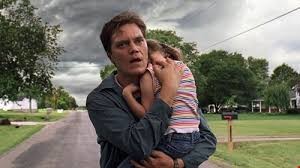
Michael Shannon and Jaeden Lieberher in “Midnight Special”
An alternative version could have been told very simply: a special young boy gets sick and dies, despite heroic efforts to save him by his father and mother. Perhaps that was the real story from which Midnight Special evolved.
The filmmakers ramped up the tale’s power by making the boy special special special, i.e. possessed of powers that can bring satellites down out of the sky and cause the entire US government to chase him halfway across the country.
We may fictionalize all we want, as long as we stay on-theme.
When Ernest Hemingway gave Jake Barnes, his fictional protagonist in The Sun Also Rises, an emasculating war wound, he was heightening reality indeed. But that heightened reality was 100% on-theme.
The theme of The Sun Also Rises is the soul-devastation that the horrors of WWI wreaked upon Hemingway’s “Lost Generation” contemporaries. Hence the wound.
There’s a storytelling axiom in Hollywood:
If horses can fly, you’ve got a story. If everything can fly, you’ve got a mess.
When we fictionalize on-theme, we heighten the drama legitimately. When we make sh*t up off-theme, we just produce craziness.
The first principle we talked about in this series was
Make the internal external
Or put another way
Make the invisible visible.
We can make ourselves cowboys or princesses or private eyes as long as that external story is on-theme with our real-life internal one.
What was Rocky but Sylvester Stallone’s fictionalized-on-theme rendition of his own struggles as an unknown trying to get noticed in the movie biz?
What was Luke Skywalker’s journey from the evaporator farm on Tatooine to saving the galaxy as a Jedi knight, except George Lucas’ own odyssey from his boyhood in Modesto, California to entertainment immortality? For that matter, what was American Grafitti?
Fictionalize as much as you want, but keep it on-theme.
January 6, 2017
Common Sense
I started off 2017 digging into two publishing rabbit holes.
The first one is related to a guy named Paine. He wrote a pamphlet that went viral a few hundred years ago and is still being read today.
Not long after the Battles of Lexington and Concord, Thomas Paine hit U.S. soil. He worked, got political at pubs, and wrote. Paine toiled away on a series of letters to be run in local newspapers. After finding himself way over word count for letters, he decided to publish a pamphlet instead, titled “Common Sense.”
Here’s what your high school teacher didn’t share about “Common Sense” and Paine:
When it came time to publish, Paine went to a printer/publisher/bookseller — a guy named Robert Bell. Bell struck a deal with Paine. He’d print the pamphlet, help promote it, and then split the profits with Paine. If there weren’t any profits, Paine would “make good” with Bell on the printing. Kind of a mash-up of today’s traditional and self-publishing worlds.
Bell printed the pamphlet and then advertised it in local newspapers. Demand increased and “Common Sense” took off. Its popularity lead Paine to add an index and other commentary in advance of the next print run.
Before the reprint, however, Paine heard about the death of General Montgomery and the struggles in the north, and decided to buy mittens for the soldiers. It was winter. They were in camps. No heaters. So . . . Off Paine went to Bell, to obtain his share of the profits.
Bell said there weren’t any profits.
No profits? How was that possible? There was a demand for a reprint, thus there had to be profits.
If this article was the movie Goodfellas, this would be the time to cue a voice-over from Ray Liotta, giving the full skinny on exactly how things went down.
Think of all the stories of young artists who sign a deal too good to be true — the kind where they do the creative work and someone else finances ads and videos and everything else, and somehow the young artist sells millions of albums but the only one making money is the publishing house, because profits aren’t available until everyone BUT the artist is paid.
Paine and the printer got into a battle. A public battle. Today it would have played out in tweets. Back then it rolled out in long letters/articles printed in local newspapers. Think of political groups today that write a letter to the president or someone else on their shit-list, then have 100+ famous people sign it, and then take out a full-page ad in the New York Times to print it. Except with Paine and Bell, the two didn’t stick to one letter. They kept at it for a month, letters back and forth in newspapers — and the public ate it up.
During the fighting, Paine took “Common Sense” to another printer. The demand was high, so the new printer outsourced some of the printing to two other printers — and this time Paine paid the bill. While this was going on, Bell released his own new version, which included packaging “Common Sense” with other non-Paine content. His version sold, and he and Paine continued fighting.
In the end, Paine didn’t make any money on the publication of “Common Sense,” but he did help fuel a revolution, and American kids today can’t get through school without hearing about “Common Sense.”
(This is my abbreviated version. Read the full publication history, including reproductions of Paine’s and Bell’s fighting columns, via The Bibliographical Check List of Common Sense With An Account of Its Publication by Richard Gimbel, starting at page 15.)
I started digging into this week’s second rabbit hole following Ev Williams’ announcement that Medium is laying off staff and shuttering offices in Washington, D.C., and New York City.
As I read Nate Hoffelder’s take, “Medium Lays Off A Third of Its Staff, Realizes Stealing Underpants is Not a Viable Business Model” and then reread his column from last year, “On Moving a Blog to Medium” I thought about Paine and how the more things change the more things stay the same.
I used to receive e-mails asking why Steve wasn’t on Huffington Post. This past year that question morphed into, “Why isn’t Steve on Medium?”
Here’s a bit of a ramble. Stick with me. I promise I’ll circle back around.
I subscribe to what Wil Wheaton wrote about a year ago, about not working with outlets that don’t pay. “Exposure” doesn’t pay the bills.
Huffington Post sold for $315 MILLION and Ariana Huffington went home with $21 MILLION and a lot of writers never saw a penny of it.
But… Exposure, right?
Well what about the people just starting you might ask? They don’t have Wil’s or Steve’s platform.
To answer this question let’s head to Louis C.K., and reread the quote I pulled from him back in 2013.
In a New York Times interview with Louis C.K., Dave Itzkoff commented, “You have the platform. You have the level of recognition.”
Louis C.K. replied with a question: “So why do I have the platform and the recognition?”
Itzkoff answered, “At this point you’ve put in the time.”
Pause after you read Louis C.K.’s follow-up:
There you go. There’s no way around that. There’s people that say: “It’s not fair. You have all that stuff.” I wasn’t born with it. It was a horrible process to get to this. It took me my whole life. If you’re new at this — and by “new at it,” I mean 15 years in, or even 20 — you’re just starting to get traction. Young musicians believe they should be able to throw a band together and be famous, and anything that’s in their way is unfair and evil. What are you, in your 20s, you picked up a guitar? Give it a minute.
Louis CK of 20+ years ago invested the time so that Louis CK of today would have a platform.
This takes us back to Wil Wheaton, and a post he did in December about working for his future self. If you operate every day in favor of Future You, you’ll eventually achieve your goals. Louis CK is one example. Steve is another. It takes time.
Outside of the fact that they aren’t paying every contributor to their platforms, the thing that has always bothered me about Medium and Huffington Post, and other similar platforms, is that artists/entrepreneurs/etc use those platforms instead of building their own platforms. That’s not Medium’s fault. That’s the artist’s decision.
It’s easier for Artist Today to post to Medium than it is to build her own site so Artist Tomorrow has a place to live when yet another publishing platform dies or becomes watered down by crap.
It takes hard work and conviction to build your own thing — and it takes relationships, which are greater investments than ad dollars.
I don’t wish Medium ill, but I don’t suggest building homes on their island either. We can look back at Thomas Paine and see the same crap happening now as happened then. It’s always harder, but Future You will be happy if you use Medium and other platforms as a tool instead of THE answer. And, if there is only one thing you do, make it an investment in relationships. You need people in your corner more than anything else. That’s the bit that Medium and others don’t seem to get. It isn’t just about content and ads. It’s about the conversations and relationships you build around and in addition to that content. (Additional Medium-related articles sharing two publishers’ perspectives, one of which launched on Medium the day of Williams’ announcement: “Unexpected News from the Establishment” and “Medium and There Is Only One R.”)
As a side: A few weeks ago we started posting Steve’s Writing Wednesdays posts on Medium and LinkedIn, just to test the waters. Will we connect with new readers? Maybe. Will any of the articles be originals for those platforms? No. We’re fine with a visit, but they’ll never be home.
January 4, 2017
Supporting Characters in Your Real Life
Remember when Michael Jordan got into trouble for referring to his teammates on the Chicago Bulls as “my supporting cast?”
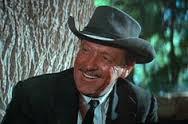
William Holden in “The Wild Bunch”
He was, of course, only telling the truth. (Though Scotty Pippen, we must admit, has a right to be a little miffed.)
But back to you and me and our novels based on our real lives. What about our spouses and kids and bosses and friends and the other crazy characters we’re going to write about? They may not like to think of themselves this way, but ..
They are supporting characters in our story.
Putting their egos aside, the question becomes
How do we as writers portray these individuals?
Are we free to change them? Can we put dialogue into their mouths that the real-life personalities never said or would never say? Can we have them do things that they didn’t do or wouldn’t do in real life?
Yes, yes, and yes.
We said in an earlier post that you and I, crafting a fictional version of our real-life story, have to detach ourselves emotionally from our real selves (if we ourselves are the hero of the story we’re telling). We need to step back and gain perspective. We must be able to see our real-life self coolly and objectively, the way a stranger would see him or her. Then and only then can we write that character on the page.
Same for supporting characters.
Your mother Joann, as soon as you start to write about her, has ceased to be Joann. She is now “Joann.” Your feckless ex-husband Dwayne has now become “Dwayne.” (Or whatever name you choose to call him.)
Let’s return for a moment to my favorite subject: theme.
Flashing back to our basic principles of storytelling, we recall that
The protagonist embodies the theme.
And that principle’s corollary:
Every supporting character represents an aspect of the theme.
(By the way, this same principle applies not just to characters, but to animals, to inanimate objects, to Jack Nicholson’s sliced-up nose in Chinatown, and to William Holden’s six-gun in The Wild Bunch. None of these exists only as itself. Each represents an aspect of the theme.)
In The Knowledge, my cat Teaspoon (the fictional version of my real-life cat Mo) represented my character’s Muse. In other words, an aspect of the theme.
In The Knowledge, the city of New York represented the greater creative life, both internal and external, that I (my character, Stretch) was trying to learn to navigate. So did the city of London.
The fictional Nicolette represented a realized artist. She was the ideal that Stretch was trying to achieve. Again, an aspect of the theme.
The fictional Peter represented an artist who went too far into the potential insanity of the creative process. His fate stood for the dark side of this enterprise. Like Jimi Hendrix or Janis Joplin, he represented the fear Stretch had for his own future.
What about the real people upon whom these characters were based? Were they exactly as The Knowledge portrayed them?
No.
The real woman upon whom Nicolette was based was a true, realized artist. But she never read me the Riot Act like she did in Chapter 32 in The Knowledge. Her diatribe in that chapter is a straight-up recital of the book’s theme. I, the writer, put those words into “Nicolette’s” mouth.
This is exactly what you have to do with your mom Joann and your ex-husband Dwayne.
What does “Joann” represent in your story? What aspect of the theme does “Dwayne” stand for? Should there be a scene where “Joann” dumps a platter of steaming spaghetti down the front of “Dwayne’s” trousers? Should “Dwayne” dive into the frigid waters of Sheepshead Bay to save “Joann” when she spills off the stern of your second husband’s fishing boat?
Yes, if the scenes mean something to the story. Yes, if they are on-theme. Yes, if what Joann represents and what Dwayne represents come together in that way as part of your story.
This is how a writer thinks.
This is how a writer structures a story.
The real Joann may be pissed off (or she may be delighted) by the Pasta Scene or the Sheepshead Bay Rescue. But that should be no concern to you, the writer. And it certainly won’t mean a thing to the reader.
You are telling a story about “yourself” and “Joann” and “Dwayne” and all the other nutty inhabitants of your own nutty life. Your fidelity is to that story—and to the fortunate strangers who will read it.
The real Joann and the real Dwayne? They’ll just have to get over it.
December 30, 2016
The Power of Negative Thinking
[I’ll return to my Love Story mini-series in my next What it Takes post in the new year. In the meantime, this oldy by goody from 2015 is worth another look. ]
So just how do you take your story to the end of the line…to the limits of human experience?
The storyteller needs a tool to not only understand this concept, but to evaluate whether or not they have successfully done so. And if you’re writing a big story, you have to go to the end of the line.
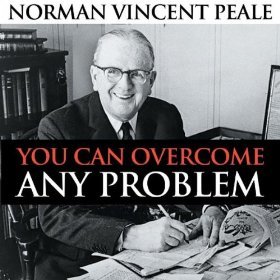
Positive Thinking Gets All the Press
The trick to figuring out how to do that is discovering what Robert McKee calls the negation of the negation of your global story value. Once you understand the negation of the negation of a global story value you will discover whether or not your draft or your murky foolscap sketch for a story has legs. And in the process, if you do this work early and often, you’ll be able to clearly understand the obligatory scenes and promises that you are making to the reader by your choice of genre and or mix of genres.
Let’s take a step back and look at Story values again.
What the Hell am I talking about when I use the phrase “story value?”
A Story value has nothing to do with “family values” or financial currency. A story value is simply a human experience (a judgment of reality) that can change from positive to negative or negative to positive. It’s best to just list a whole slew of them so that you’ll get the gist. Alive/Dead, Truth/Lie, Love/Hate, Justice/Injustice, Hope/Despair, Good/Evil, Right/Wrong, Happy/Sad, Naïve/Experienced, Young/Old, Smart/Dumb, Rich/Poor, Freedom/Slavery, Honor/Shame, Chosen/Ignored, etc.
Where one goes off track is in forgetting that these story values aren’t just black and white polarities.
There are progressive degrees of positivity or negativity for each.
For example, the opposite of love may be hate, but there is something in between love and hate that is worse than love but less than hate. That in between is called indifference. And there is also something worse than hate. That something is what Robert McKee coined as the “negation of the negation.” And for the love/hate spectrum, the negation of the negation is “hate masquerading as love” or “self-hatred.”
Let’s look at a very popular external content genre, crime fiction, and examine the core value at stake in four different ways. [It’s not necessary, but if you’d like to dive deeper into what I mean about external content genres, click here]
The story value at stake for crime fiction is JUSTICE.
A crime has been committed.
Will the crime be solved?
Will the perpetrator be brought to justice? That’s basically it.
By choosing the crime genre the first promise you are making to a reader is an answer to these two fundamental questions.
But we’d all agree that there are varying degrees of crime right?
Stealing a piece of candy from a drugstore is far less of a crime than the wholesale slaughter of an entire village. There is a wide spectrum of mendacity. Because there is such a wide band, the writer has a choice of how far to take his story. As every story must progressively complicate, a crime story needs to begin one place, get more and more difficult to solve, and then end in a surprising but inevitable final solution or conundrum. Just how far you take the crime (how globally threatening it is) requires you to figure out exactly where the line ends in terms of the JUSTICE value.
To do that, we need to look at the negative progression (or degradation) of the value at stake.
So let’s begin with the POSITIVE end of the spectrum, which is JUSTICE, and place that at the very left of our degradation line. And we know that the opposite of JUSTICE is INJUSTICE, so let’s put that down the line on the right hand side, further away from the epitome of positive.
JUSTICE INJUSTICE
But we also all know that there’s more to the negative world than injustice. There’s crime with extenuating circumstances…like the thief who steals a loaf of bread to feed his starving children. Did the man steal the bread and did the owner of the store lose a valuable asset?
As Arnold Schwarzenegger would say: “Where there’s smoke, there’s fire, that is true.”
But is this an offense that threatens society?
No.
So somewhere between JUSTICE and INJUSTICE lies a nether region of unfairness. It’s unfair to the owner of the store not to be compensated for his bread. But the fact that the bread was used to feed starving children—a good outcome from a bad act—lessens the act’s venality. So between justice and injustice, let’s put UNFAIRNESS, which is something in between black and white.
JUSTICE UNFAIRNESS INJUSTICE
Now the question arises, is there something worse than an Injustice?
The bad mojo that off the charts sociopathic narcissists bring into the world is something more than just unjust, isn’t it? The serial killer or warlord or fascist genocidal perpetrator is emblematic of a world that is always unjust. In this kind of world, there is no justice. By definition, it is run with complete unpredictability. The rules are changed whenever it suits the whims or desires of a central body or figure.
That kind of more negative than the opposite JUSTICE is the world of Tyranny.
So on a straight line spectrum from positive to negative, let’s put Tyranny even further to the right of injustice.
JUSTICE UNFAIRNESS INJUSTICE TYRANNY
To recap, while there is a direct opposite of Justice (injustice), the value has far more nuance than purely positive or purely negative. There is the degree of negativity less than the direct opposite, unfairness, and the degree of negativity far more abhorrent than the direct opposite, Tyranny.
It is the darkest of the dark that McKee has termed the Negation of the Negation.
Here’s the way I would chart the spectrum of positive to negative
JUSTICE (+) UNFAIRNESS (+/-) INJUSTICE (-) TYRANNY (- -)
If we were asked to assign a power of ten number for each of these (the number one being the most positive and number ten being the most negative), it would look like this:
JUSTICE (1) UNFAIRNESS (3) INJUSTICE (7) TYRANNY (11)
If you’ve ever seen the movie SPINAL TAP, I think you know where we should try and reach by the end of our crime story.
Using the power of ten system by assigning a numeric value to the degree of negativity can help you track the progression of your story.
The beginning section of your story should progress from say a 1 to a 4, the middle from 4 to an 8 and the end from an 8 to an 11. The resolution of the story would then bring the story full circle, back to 1, or end on a more somber note, ending on 8 or even 11.
If your crime story is a straight action James Bond kind of thing like THUNDERBALL or LIVE AND LET DIE then your resolution will circle back to Justice, 1…all’s well again in the world. James Bond has fixed it. Major positive ending.
But if your story is APOCALYPSE NOW of CHINATOWN, you’re going to end on a 11 on the negativity scale. The world is a mess and we’ve gone completely to the dark side. It’s every man for himself.
What about those stories that have a positive ending for the global story, but have an ironic twist?
Is there a way for a crime story to somehow return the global story value back to Justice (or life back to life in the case of the thriller, action story or horror story) but do it ironically? That is, bring a criminal to technical justice, but lose something in the process?
If your story is DIRTY HARRY, you can accomplish this irony through your choice of theme/controlling idea.
DIRTY HARRY ends on a positive/negative combo plate of irony. Our cop gets the guy and justice is served but he breaks the law doing it and leaves his job in disgust (remember he throws away his badge at the very end). The world no longer has a vicious killer in it, but the kind of man who can take him out has been lost too. The only way to stop the killers is to empower fascists/”good” killers is one interpretation of the theme/controlling idea of DIRTY HARRY.
Another way to add irony to story is to add an internal genre along with its inherent value progression underneath the global external genre. That is, the protagonist undergoes an internal quest as well as an external quest in the story. The external genre ends on the positive, while the internal genre ends on the negative, thus producing irony.
An example of that scenario would be the movie THE SOCIAL NETWORK… The lead character wins the Business Performance external genre (Facebook is a huge hit) but fails his internal morality test plot (he succumbs to the temptations of wealth and power at the expense of real connection to fellow human beings).
Bottom line, should you wish to reach the pinnacle of your chosen genre/s (don’t we all?) you must think deeply and clearly about the negation of the negation and how best to express its arrival in your story.
[Join www.storygrid.com to read more of Shawn’s Stuff]



